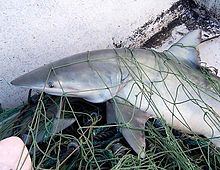
Back صيد عرضي Arabic Captura accessòria Catalan Vedlejší úlovek Czech Beifang (Fischerei) German Παρεμπίπτουσα αλιεία Greek Aldona kaptado Esperanto Captura accesoria Spanish صید جانبی Persian Sivusaalis Finnish Prise accessoire French

Bycatch (or by-catch), in the fishing industry, is a fish or other marine species that is caught unintentionally while fishing for specific species or sizes of wildlife. Bycatch is either the wrong species, the wrong sex, or is undersized or juveniles of the target species. The term "bycatch" is also sometimes used for untargeted catch in other forms of animal harvesting or collecting. Non-marine species (freshwater fish not saltwater fish) that are caught (either intentionally or unintentionally) but regarded as generally "undesirable" are referred to as rough fish (mainly US) or coarse fish (mainly UK).
In 1997, the Organisation for Economic Co-operation and Development (OECD) defined bycatch as "total fishing mortality, excluding that accounted directly by the retained catch of target species".[1] Bycatch contributes to fishery decline and is a mechanism of overfishing for unintentional catch.[2]
The average annual bycatch rate of pinnipeds and cetaceans in the US from 1990 to 1999 was estimated at 6215 animals with a standard error of 448.[3]
Bycatch issues originated with the "mortality of dolphins in tuna nets in the 1960s".[4]
There are at least four different ways the word "bycatch" is used in fisheries:[5]
- Catch which is retained and sold but which is not the target species for the fishery [citation needed]
- Species/sizes/sexes of fish which fishers discard[6]
- Non-target fish, whether retained and sold or discarded[7]
- Unwanted invertebrate species, such as echinoderms and non-commercial crustaceans, and various vulnerable species groups, including seabirds, sea turtles, marine mammals and elasmobranchs (sharks and their relatives).
Additionally, the term "deliberate bycatch" is used to refer to bycatch as a source of illegal wildlife trade (IWT) in several areas throughout world.[8]
There are several tools to estimate bycatch limits—the maximum number of animals that could be sustainably removed from a population impacted by bycatch. These include the 'potential biological removal' (PBR) and the 'sustainable anthropogenic mortality in stochastic environments' (SAMSE), which incorporates stochastic factors to determine sustainable limits to bycatch and other human-caused mortality of wildlife.[9]
- ^ OECD (1997) Towards sustainable fisheries: economic aspects of the management of living marine resources. OECD Paris.
- ^ C. Michael Hogan. 2010. Overfishing. Encyclopedia of Earth. National Council for Science and the Environment. eds. Sidney Draggan and C. Cleveland. Washington DC.
- ^ Read, Andrew J.; Drinker, Phebe; Northridge, Simon (February 2006). "Bycatch of Marine Mammals in U.S. and Global Fisheries". Conservation Biology. 20 (1): 163–169. Bibcode:2006ConBi..20..163R. doi:10.1111/j.1523-1739.2006.00338.x. PMID 16909669. S2CID 157350.
- ^ Cite error: The named reference
Hallwas invoked but never defined (see the help page). - ^ Alverson D L; Freeberg M K; Murawski S A; Pope J G (1994). A global assessment of fisheries bycatch and discards. Rome: FAO.
- ^ A definition used particularly in the northeast and western Pacific and in US legislation
- ^ Hall, M A (1996). "On bycatches". Reviews in Fish Biology and Fisheries. 6 (3): 319–352. Bibcode:1996RFBF....6..319H. doi:10.1007/BF00122585. S2CID 25760363.
- ^ Ermolin, Ilya; Svolkinas, Linas (January 2018). "Assessment of the sturgeon catches and seal bycatches in an IUU fishery in the Caspian Sea". Marine Policy. 87 (87): 284–290. doi:10.1016/j.marpol.2017.09.022.
- ^ Manlik, Oliver; Lacy, Robert C.; Sherwin, William B.; Finn, Hugh; Loneragan, Neil; Allen, Simon C. (2022). "A stochastic model for estimating sustainable limits to wildlife mortality in a changing world". Conservation Biology. 36 (4): e13897. Bibcode:2022ConBi..36E3897M. doi:10.1111/cobi.13897. PMC 9542519. PMID 35122329.
© MMXXIII Rich X Search. We shall prevail. All rights reserved. Rich X Search